Are the Gods Real? Does God Truly Exist?
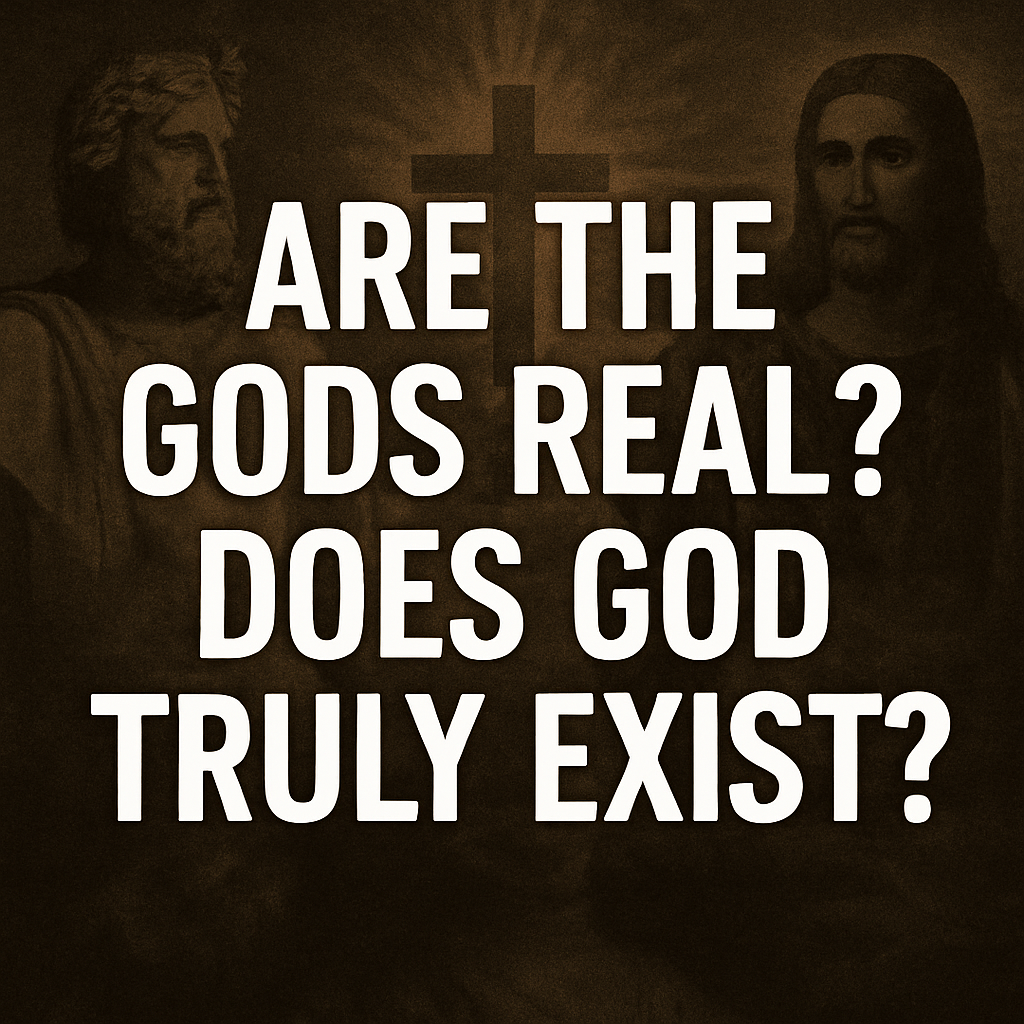
For thousands of years, humanity has looked to the skies and asked the same timeless questions: Does God exist? Are the gods who once walked among us real—or merely myths etched in stone and scripture? From the Vedic deities of ancient India to the divine beings of Egypt, Mesopotamia, and Mesoamerica, every civilization speaks of powerful entities who came from the heavens, brought knowledge, and then mysteriously vanished.
But what if these stories weren’t just symbolic? What if the gods were real—and their return is not just a myth, but a prophecy?
In this article, we explore the ancient texts, archaeological mysteries, and modern theories that suggest the gods are real—they might be coming back.
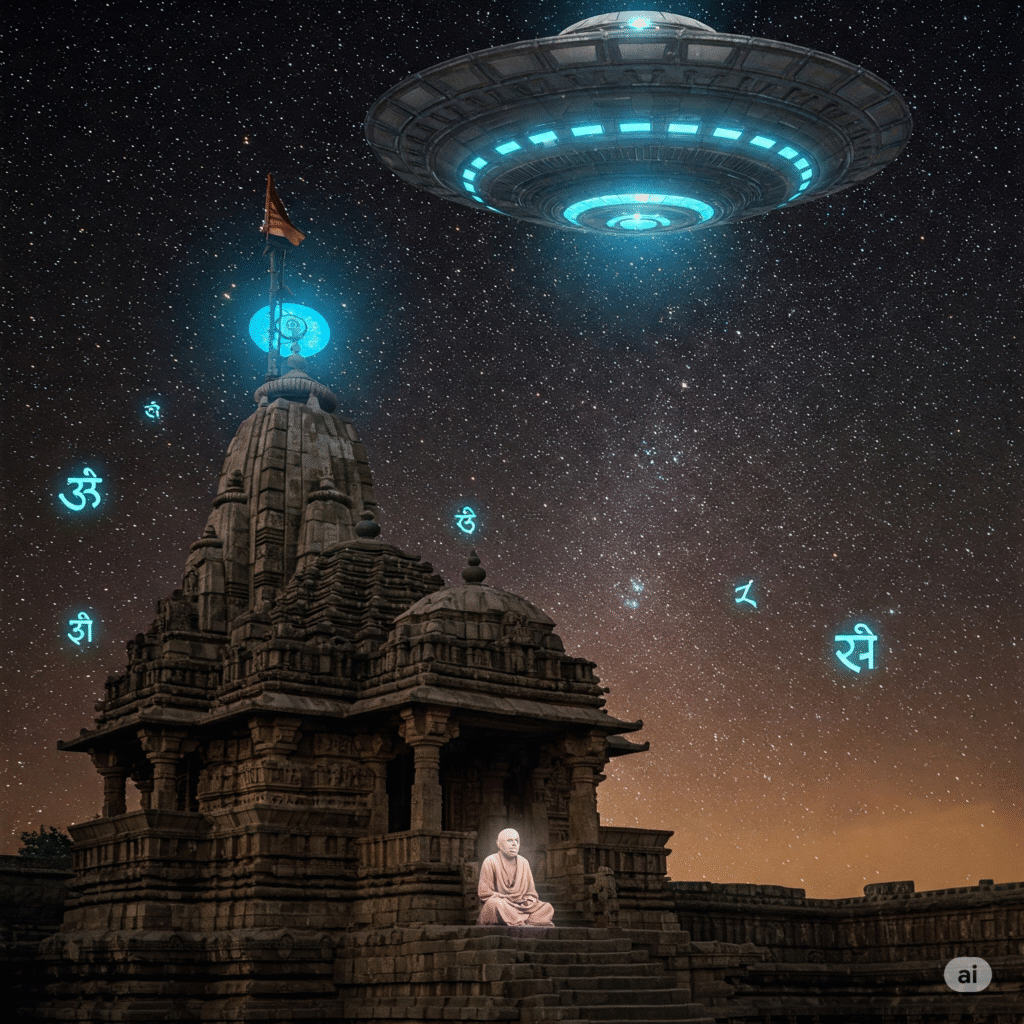
The Eternal Question — Are the Gods Real? Does God Truly Exist?
Since the dawn of humanity, we’ve stared up at the stars and asked: Is anyone out there? For thousands of years, we called them gods — beings of immense power who descended from the heavens and shaped the world. Every culture has its myths. But none are as detailed, layered, and strangely technological as those in Hinduism.
Ancient Indian texts don’t just talk about gods — they describe flying machines, precision weapons, and beings who could live forever. Could the gods of the past — Shiva, Vishnu, Krishna — have been more than just myths? What if they were real… and what we once called “divine” was actually something far more advanced?
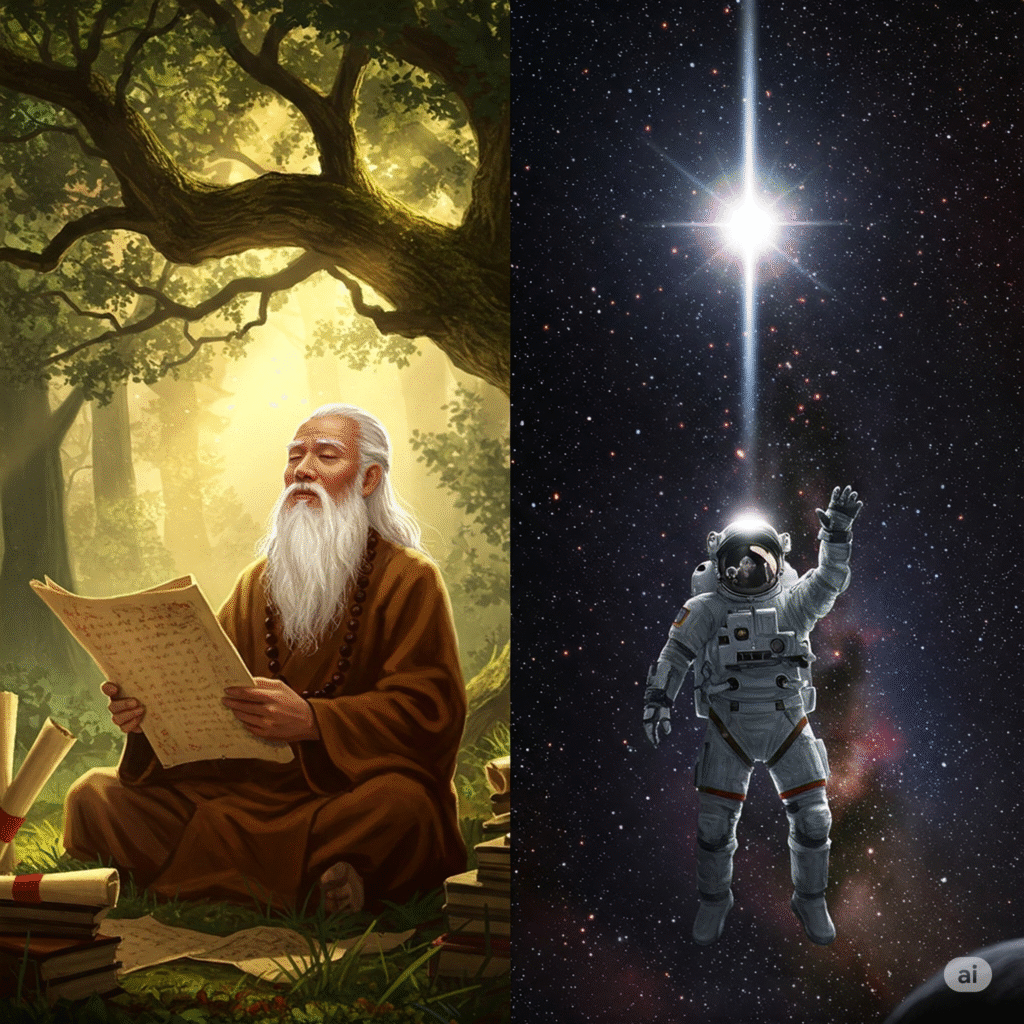
A split image: one half shows a bearded sage meditating under a tree with ancient scrolls, the other half shows an astronaut floating in space, both reaching toward the same glowing point of light in the sky.
Hindu Cosmology — A Universe Beyond Imagination
Long before science proposed theories like the Big Bang or the existence of parallel universes, Hindu philosophy had already laid out a cosmic blueprint. The universe wasn’t seen as a linear path with a clear beginning and end — it was an infinite loop of creation, destruction, and rebirth. A timeless cycle.
At the heart of this cycle are the Trimurti — Brahma the creator, Vishnu the preserver, and Shiva the destroyer. But viewed through today’s scientific lens, they seem less like deities and more like cosmic engineers:
-
Brahma writes the initial code.
-
Vishnu monitors and maintains the system.
-
Shiva resets it when it crashes.
This leads us to reconsider: Are the Gods Real? Does God Truly Exist?
Could these ancient beings actually represent intelligent forces managing a universal simulation?
Perhaps the myths weren’t myths at all — but metaphors for advanced knowledge far ahead of its time.
And if so, it forces us to ask again: Are the Gods Real? Does God Truly Exist? Or have we simply misunderstood science as spirituality for millennia?
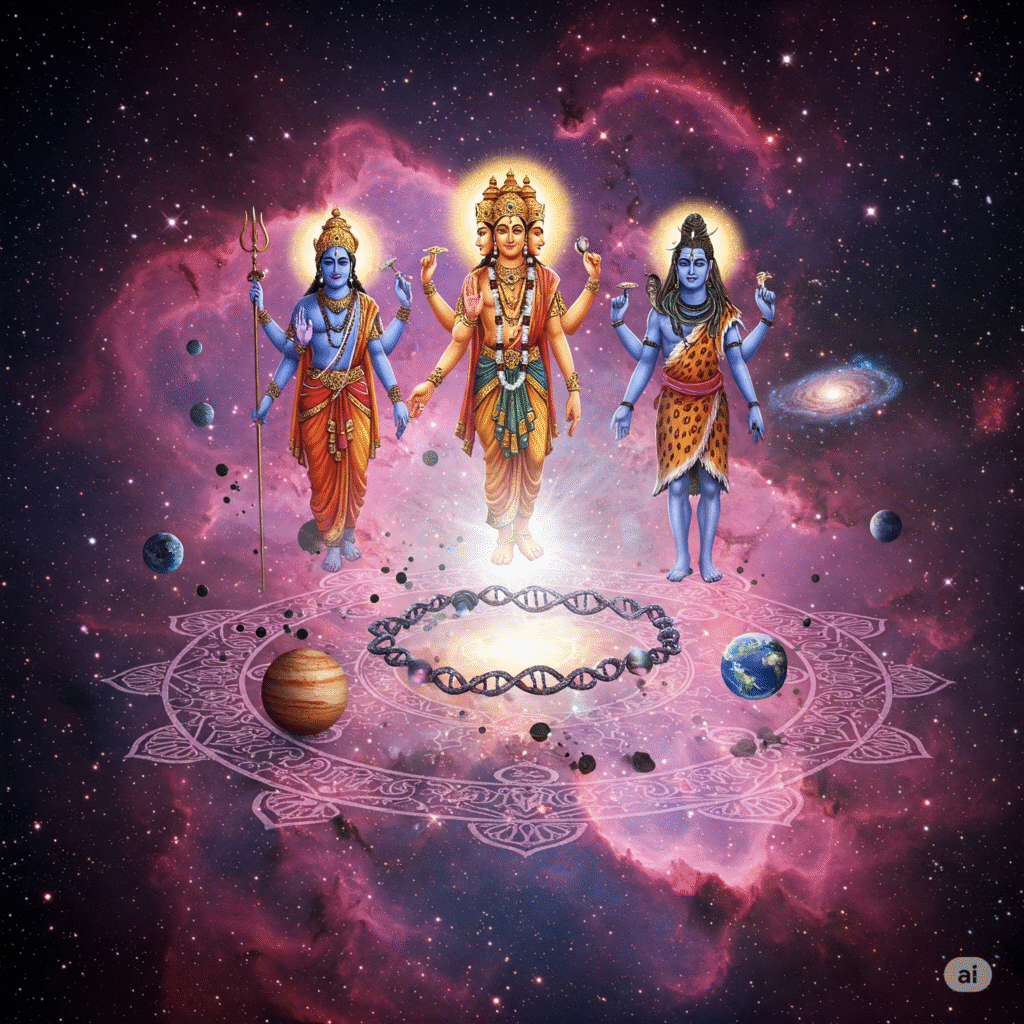
A cosmic scene showing Brahma, Vishnu, and Shiva as celestial beings operating a vast holographic universe. Planets, galaxies, and strands of DNA float around them in a mandala pattern. The background is filled with starlight and swirling nebulae.
Ancient Technology Hidden in Plain Sight
Let’s talk about weapons. Hindu epics describe missiles that could level cities, arrows that could multiply mid-air, and devices that burned entire forests to ash. The Brahmastra sounds eerily like a nuclear weapon. And Rama — hero of the Ramayana — killed 14,000 enemies with a single arrow. A bow and arrow? Or a high-tech drone strike?
Then there’s the Pushpaka Vimana — a flying chariot with no wings, powered by thought, able to shift shape mid-flight. Sounds more like a spacecraft than a poetic metaphor.
Even more chilling: ancient temples built above uranium deposits. Coincidence? Or did ancient engineers know something we don’t?
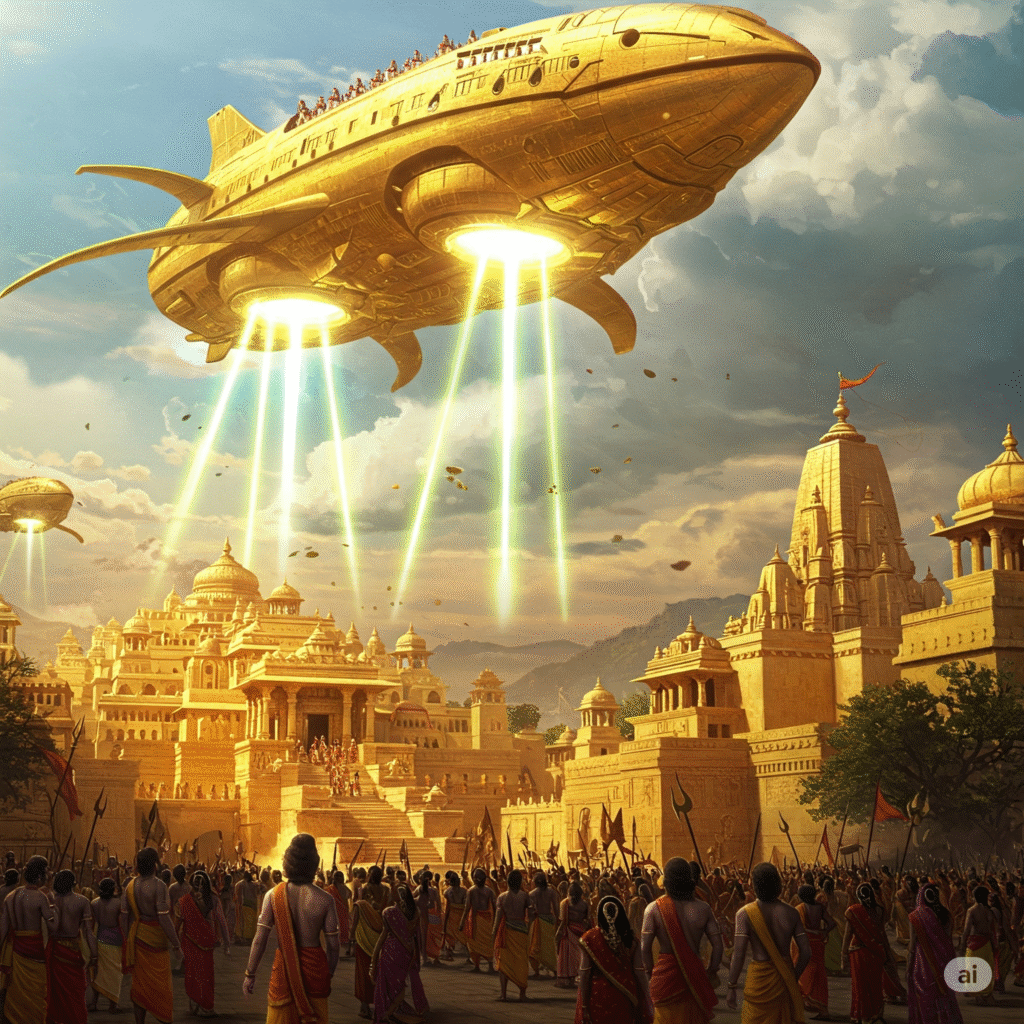
A glowing Pushpaka Vimana flying over a golden city resembling Ayodhya, with laser-like beams coming from its base. Below, people in traditional Indian clothing point upward in awe, while ancient weaponry glows in temples. Are the Gods Real? Does God Truly Exist?
The Genetics of the Gods
Forget superheroes — Hindu mythology gave us beings like Hanuman, the monkey god who could fly, change size, and was immune to fire. Sounds like a Marvel character… or a genetically engineered super-soldier.
And what about Ardhanareeswara, the half-man, half-woman form of Shiva? It may symbolize balance — but could it also hint at genetic fusion?
And then there’s Dashavatara, the ten avatars of Vishnu. Mysteriously, they follow the exact order of evolution:
- First came the fish (Matsya),
- Then the amphibian (Kurma),
- Then the boar (Varaha),
- Followed by the half-animal, half-human (Narasimha),
- And eventually, advanced human beings.
How could they have known this — unless someone told them?
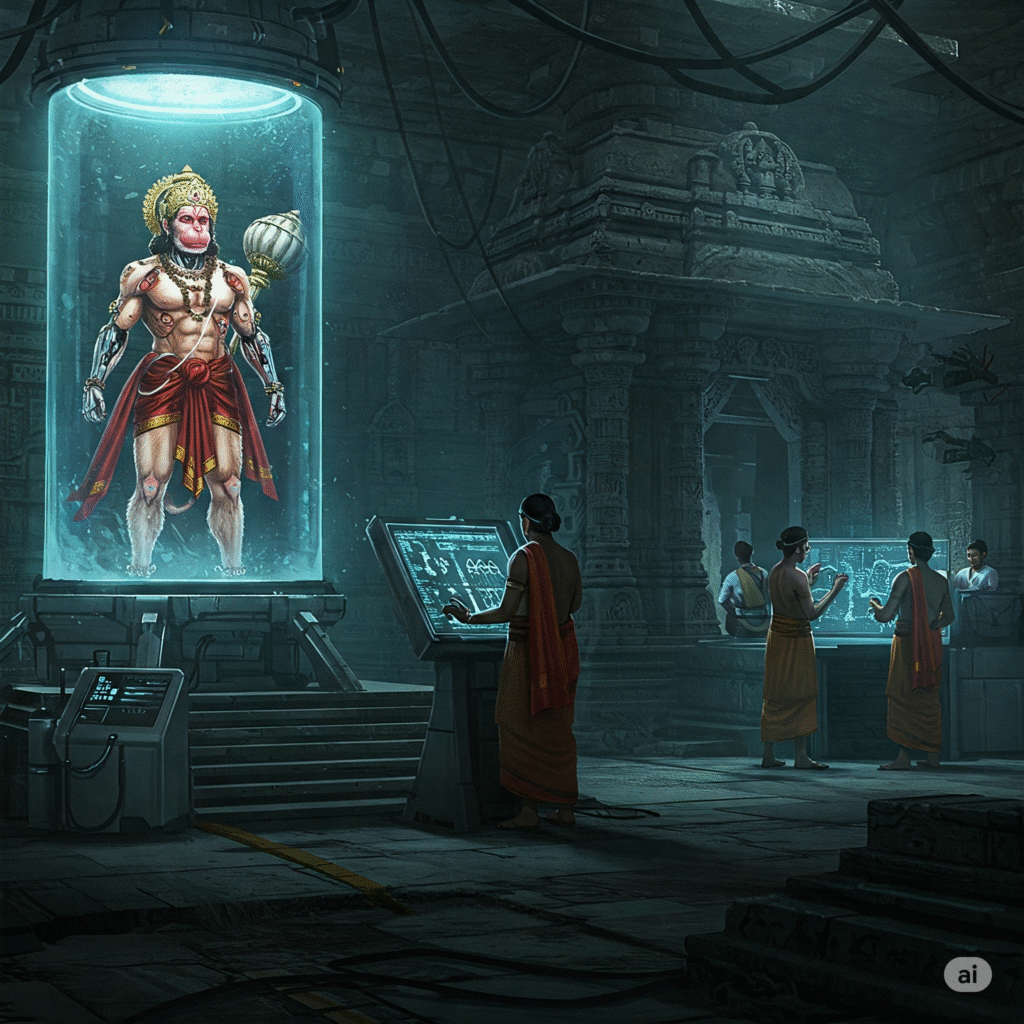
A futuristic lab merged with an ancient Indian temple. In a glass chamber stands Hanuman, part-human, part-simian, enhanced with glowing cybernetic implants. In the background, scientists in ancient robes study genetic blueprints etched on stone tablets.
Did Ancient India Record Evolution Before Darwin?
Long before Darwin proposed the theory of evolution in The Origin of Species, ancient Hindu texts had already outlined a strikingly similar progression of life. The ten avatars of Vishnu — from Matsya the fish to Kalki the future warrior — seem to mirror the evolutionary journey from aquatic organisms to advanced human intelligence. But unlike Darwin’s concept of random mutation and natural selection, these avatars appear intentional.
Each incarnation doesn’t just evolve — it arrives with a mission, to steer the direction of life itself.
Could it be that these weren’t mere metaphors, but ancient records of guided evolution?
Could divine beings have intervened — shaping species and civilizations?
It raises the deeper question again: Are the Gods Real? Does God Truly Exist?
Perhaps the avatars weren’t symbolic stories — but ancient encounters with higher intelligence.
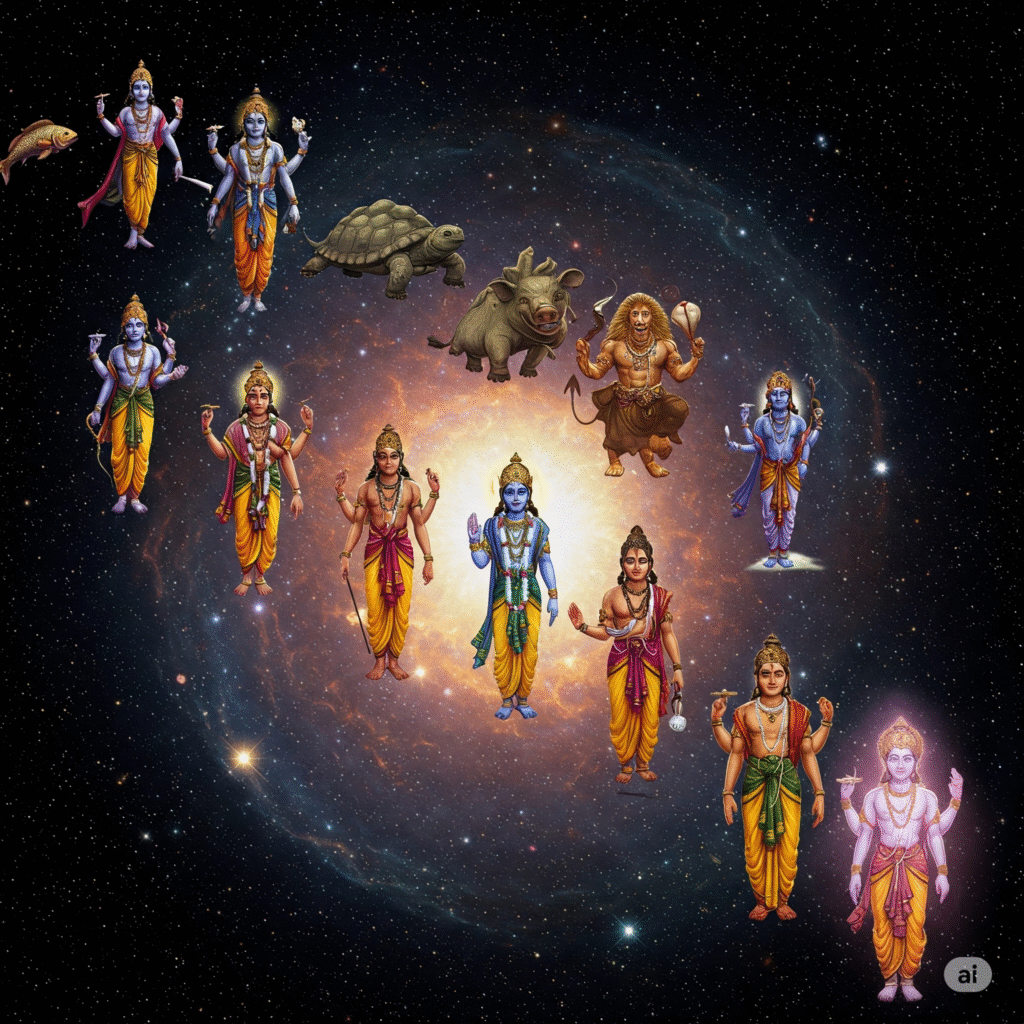
Ten avatars of Vishnu displayed in sequence like a holographic timeline: fish, amphibian, boar, half-man beast, early humans, and ending with a glowing humanoid radiating divine light — each figure more advanced than the last, set against a cosmic background. Are the Gods Real? Does God Truly Exist?
Brahma — God, or Cosmic Programmer?
Why is Brahma shown with three or four heads? Symbolism? Or a way to depict a being who could process thought from multiple directions — a biological supercomputer?
Maybe Brahma wasn’t a man sitting on a lotus, but the designer of life itself — coding DNA, setting up timelines, managing realities. The ultimate architect of our simulation.
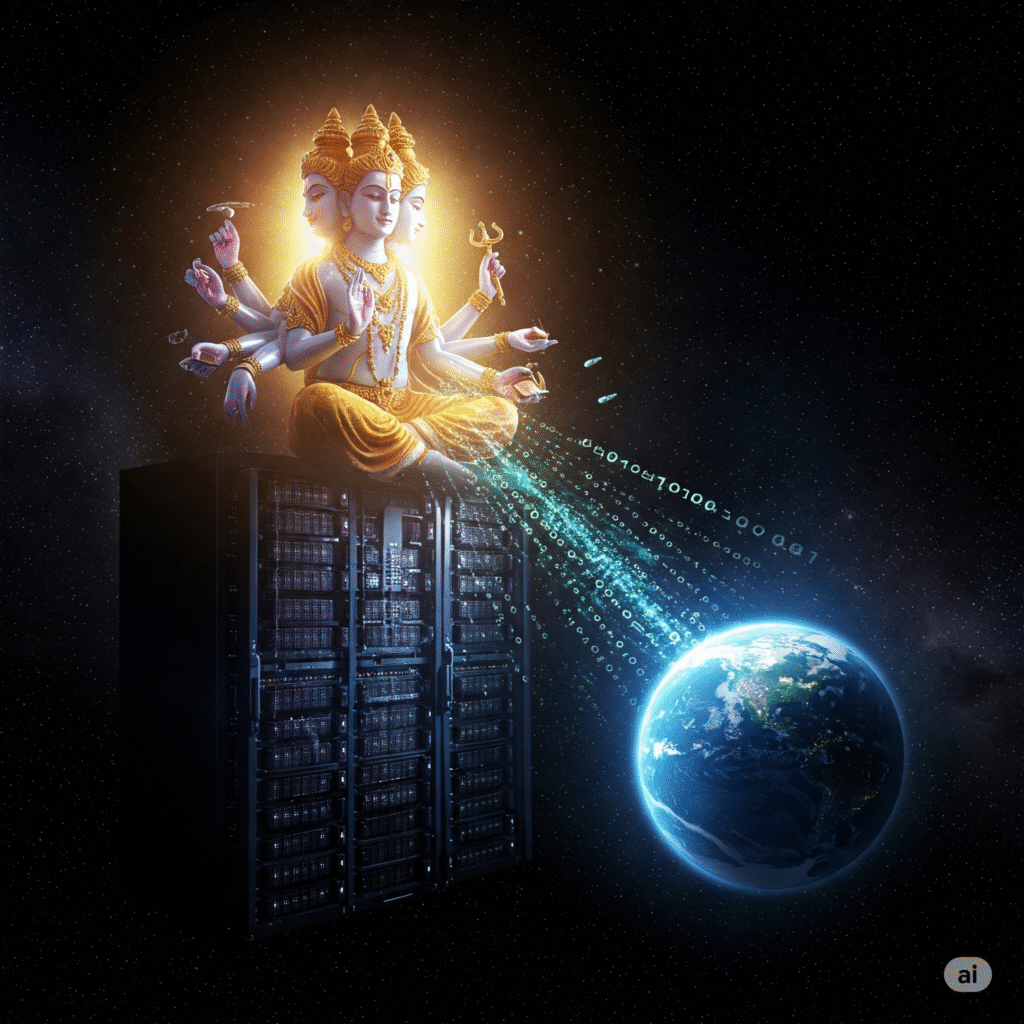
Brahma depicted as a radiant multi-headed AI being, sitting on a lotus-shaped server hub in deep space. Streams of binary code and Sanskrit letters flow from his hands into a glowing Earth below.Are the Gods Real? Does God Truly Exist?
Sky Maps Carved in Stone
Indian sages predicted solar eclipses, calculated planetary orbits, and named celestial bodies before telescopes were invented. Temples were aligned with stars, built as celestial computers using shadows and geometry to track time.
How did they know so much without technology? Maybe they didn’t learn it. Maybe they remembered it — knowledge passed down from a civilization not of this world.
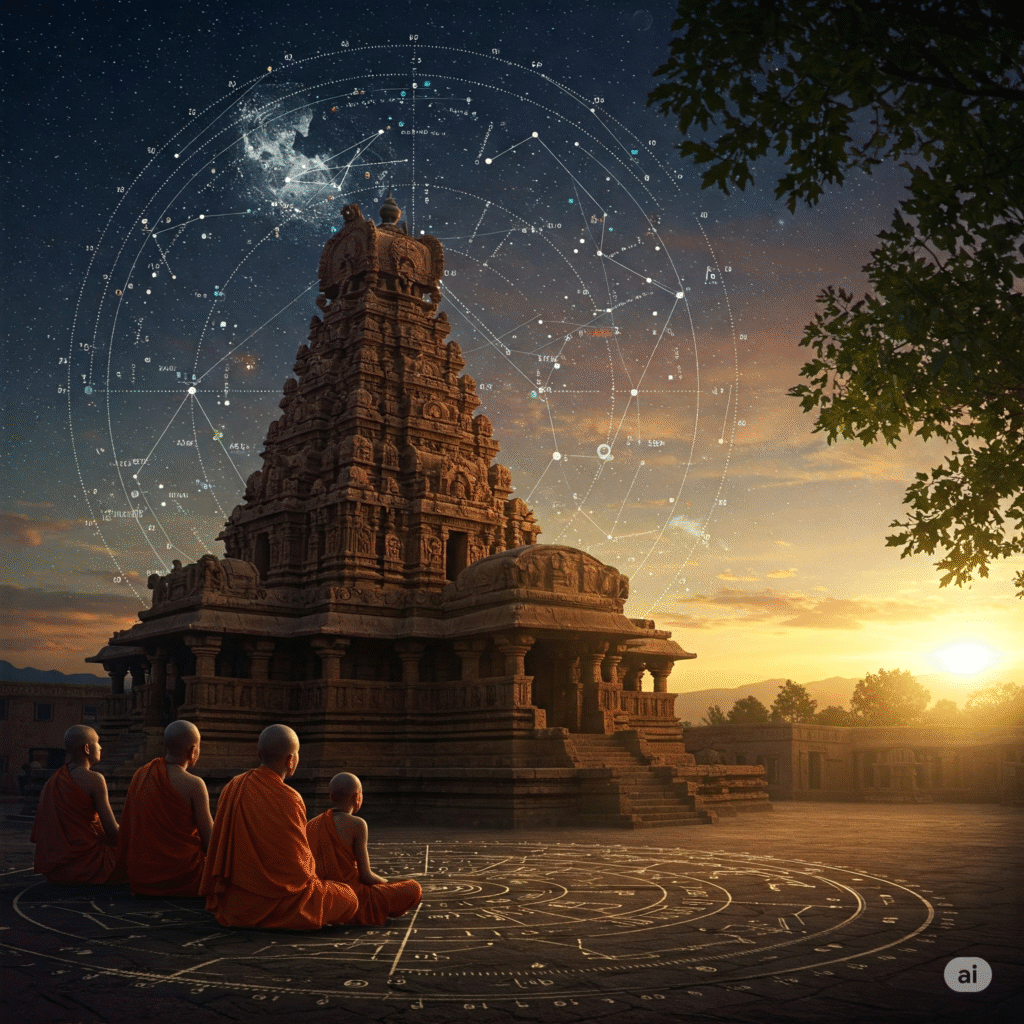
Ancient Indian temple aligned with constellations — its shadow casting a perfect star map on the ground. In the sky, a translucent overlay of modern satellite data matches the ancient carvings. Monks observe it with glowing eyes of wonder.
The Lost Cities of the Gods
Across India lie the ruins of cities like Dwaraka, said to be submerged after a divine war. Myth? Maybe. But what if these were real, ancient power centers — destroyed in a war so devastating it left behind radiation and glassed sand?
Many temples have underground vaults that remain unopened. What’s in them? Sacred relics? Or forbidden tech?
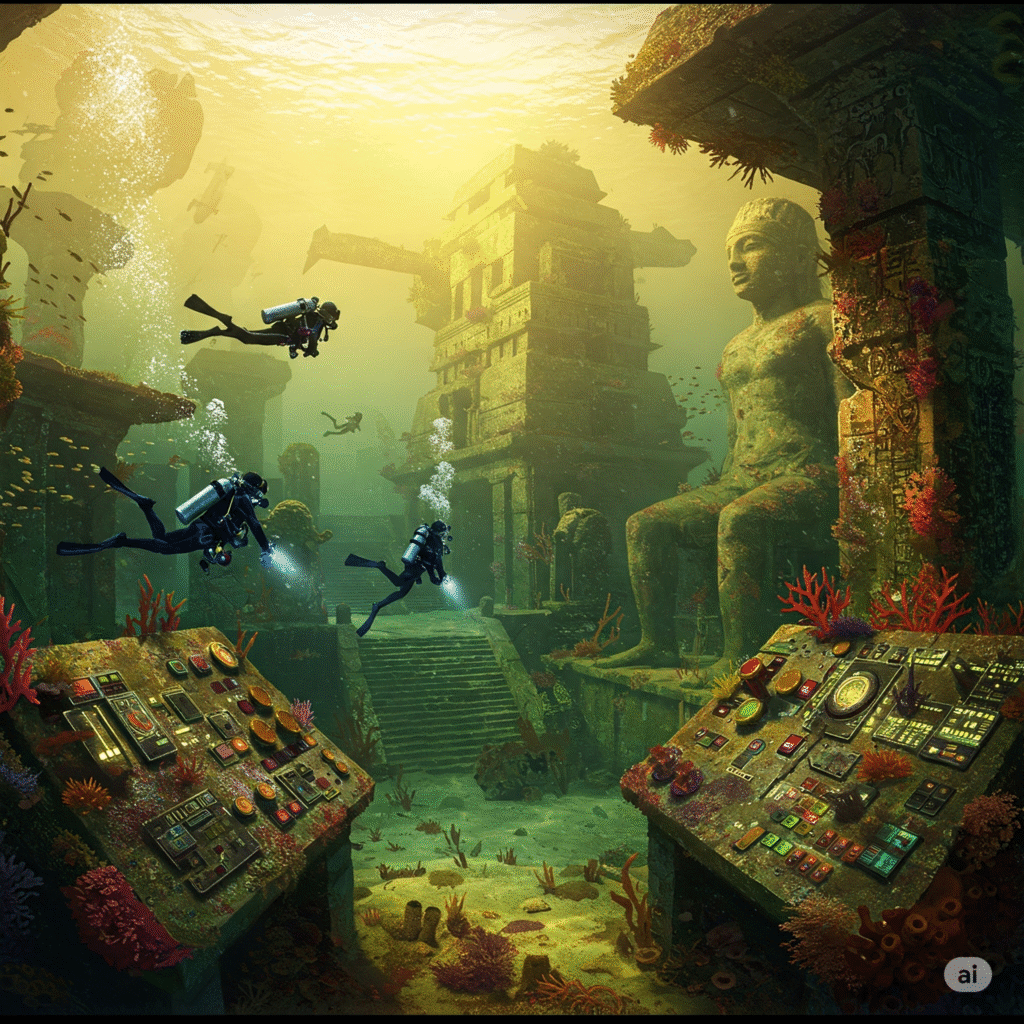
An underwater city glowing with golden light — temples and statues half-buried in coral. Divers swim near a submerged control panel with ancient levers and floating glyphs. A shadow of a giant Vimana looms in the distance.Are the Gods Real? Does God Truly Exist?
UFOs in Sanskrit
The Vimana Shastra describes spacecraft with detailed engine parts, mercury propulsion, and force fields. The gods had weapons that could track enemies, fly across dimensions, and bend time.
They even had remote communication, holographic projections, and devices that resemble modern surveillance tech.
When you strip away the poetic language, you’re left with a frightening conclusion: these weren’t myths. They were machine manuals.

A page from the Vimana Shastra glowing with otherworldly light, floating in mid-air. Behind it, a massive spacecraft rises over a mountaintop, flanked by energy fields and anti-gravity rings, with Sanskrit inscriptions glowing along its body.Are the Gods Real? Does God Truly Exist?
So Why Did They Leave?
If these beings once ruled the Earth, why did they vanish?
One theory: Humanity became too unstable. A biological mutation, or perhaps a collapse of the experiment. The gods had to quarantine us — or leave.
Another possibility: We were always meant to be an experiment. A seed of life, watched from afar. And now that we’ve reached the edge of space, they’re getting ready to return.
In Hindu prophecy, Vishnu’s final avatar — Kalki — will descend when chaos reaches its peak. Maybe that’s not a story. Maybe that’s a timer.
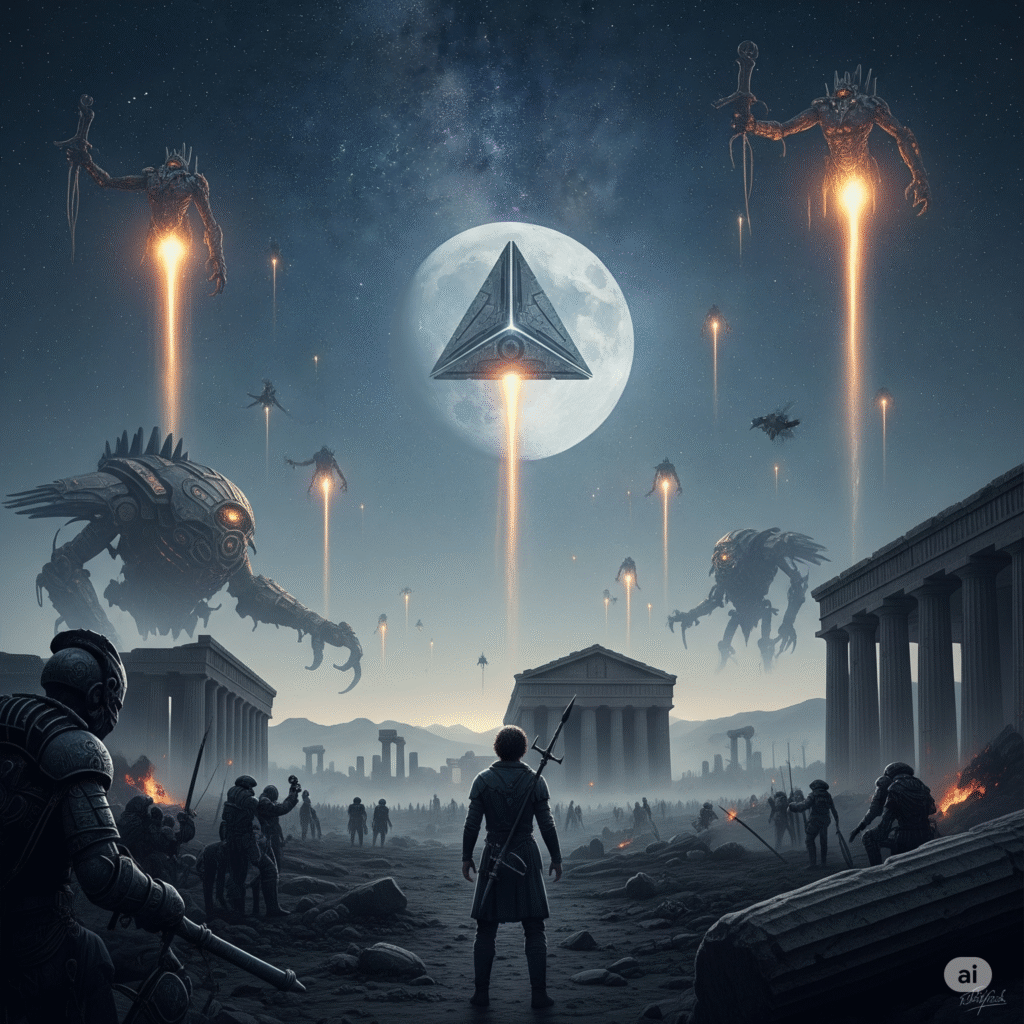
A battlefield under the stars, with gods and machines vanishing into the sky. A lone human stands watching as the light fades, temples behind him in ruin. The moon reflects a mysterious triangle-shaped craft disappearing into space.Are the Gods Real? Does God Truly Exist?
Conclusion: Were the Gods Aliens All Along? Are the Gods Real? Does God Truly Exist?
Across every chapter of our ancient texts, a recurring theme emerges: these so-called gods possessed ships, weapons, knowledge, and biological capabilities far beyond human understanding. They behaved less like divine beings and more like advanced scientists — observing life, engineering species, and disappearing once their work was complete.
It challenges us to reconsider the age-old question: Are the Gods Real? Does God Truly Exist?
Perhaps our ancestors didn’t imagine gods from thin air — maybe they simply misinterpreted advanced technology as divinity.
Or as Arthur C. Clarke said: “Any sufficiently advanced technology is indistinguishable from magic.
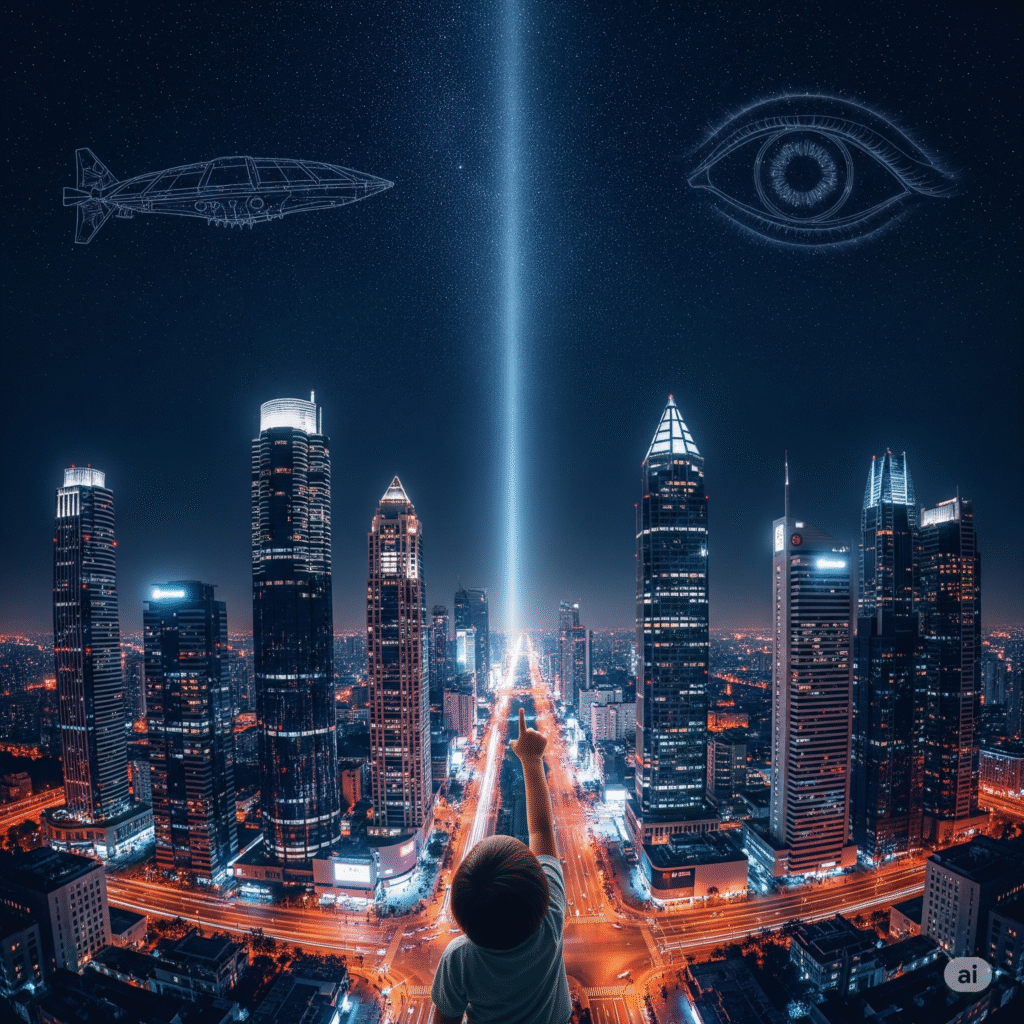
A modern city skyline at night. In the sky, hidden among stars, faint outlines of a Vimana and a cosmic eye watching Earth. Below, a child points upward as light from the heavens touches the ground in a beam.
Epilogue: Are They Still Watching?
Today, people still report strange lights in the sky. Visions. Dreams. Apparitions. Are the gods still here, hiding in another dimension, waiting? Are the Gods Real? Does God Truly Exist?
Maybe we weren’t abandoned. Maybe we’re still being watched — tested — observed.
And one day, when we’re ready, when we’ve evolved past our wars and our greed, they may return.
Not as gods…
But as our creators.
(This article is a continuation of our previous exploration The Hidden Science of Hindu Temples. Are the Gods Real? Does God Truly Exist? — where we delved into the philosophical essence of divinity. Here, we take that journey further into the physical realm, uncovering how ancient Hindu temples were designed not just for worship, but as scientific instruments to experience the divine.)
Disclaimer: The contents of this page may not be correct and are provided for informational purposes only. They should not be considered as professional advice or recommendations. Users are encouraged to verify the information independently before relying on it. The author disclaims any liability for any errors or omissions in the information provided.
Pingback: Real Evidence for Time Travel: Ultimate Mystery unlocked 1
osemkifidtrqdoxmsyndktrmisjmsq